
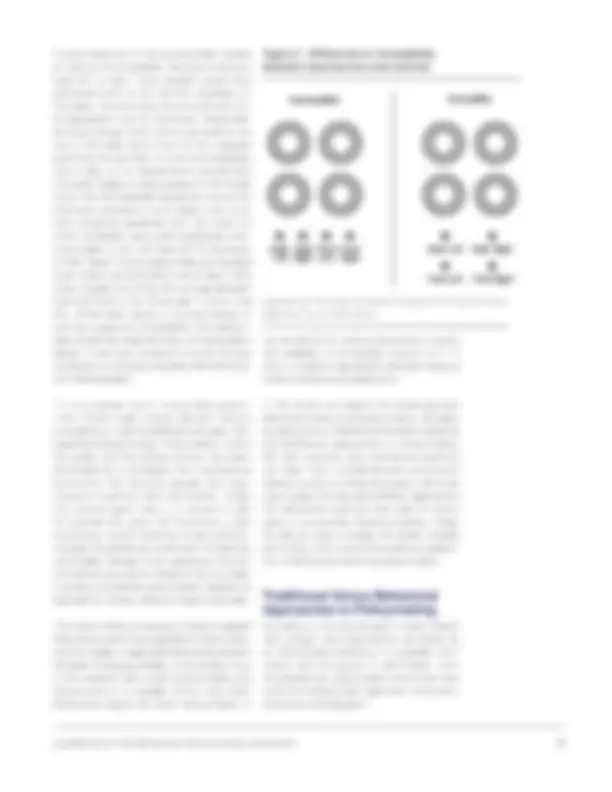
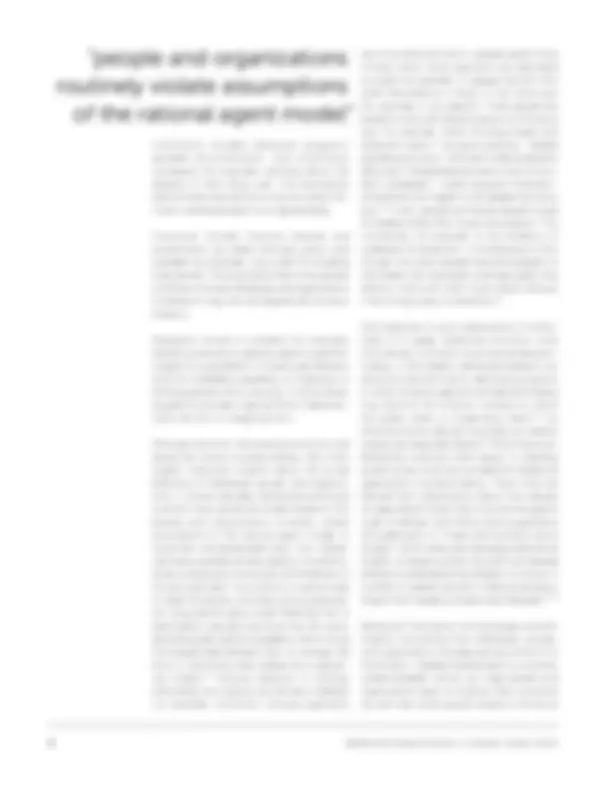
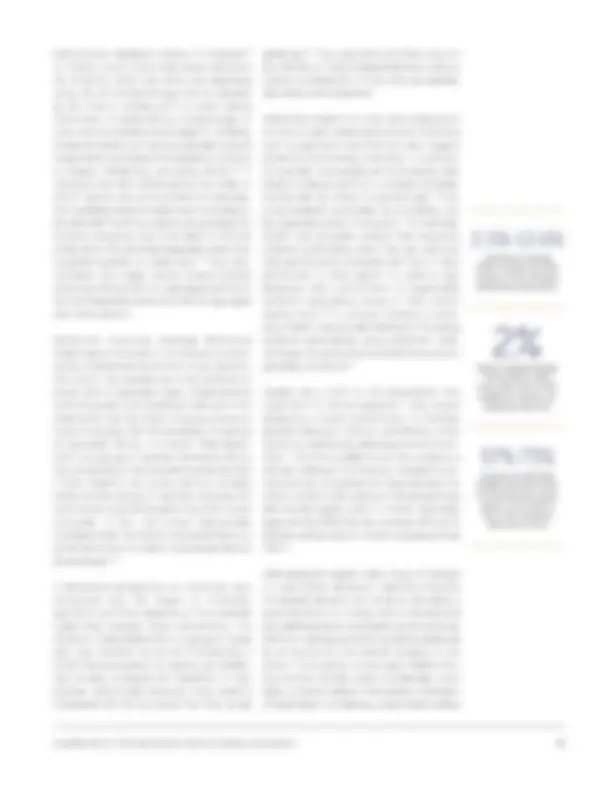
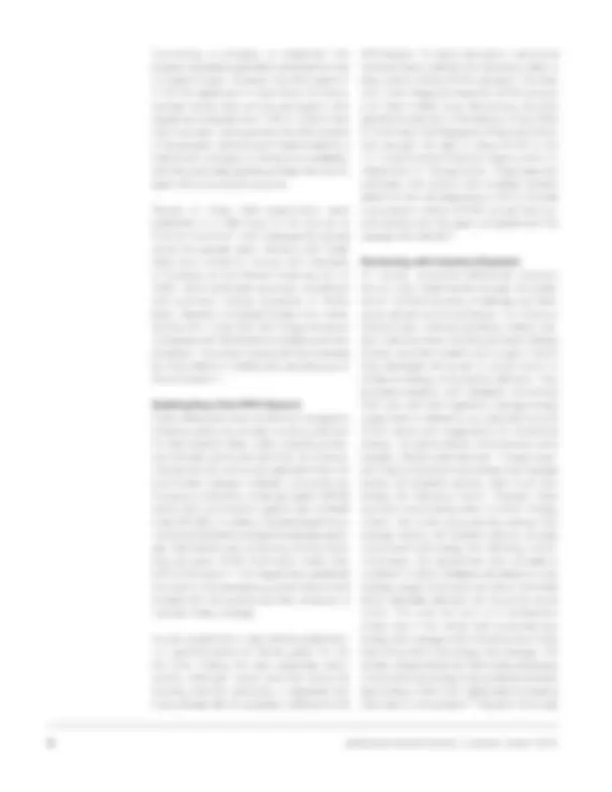
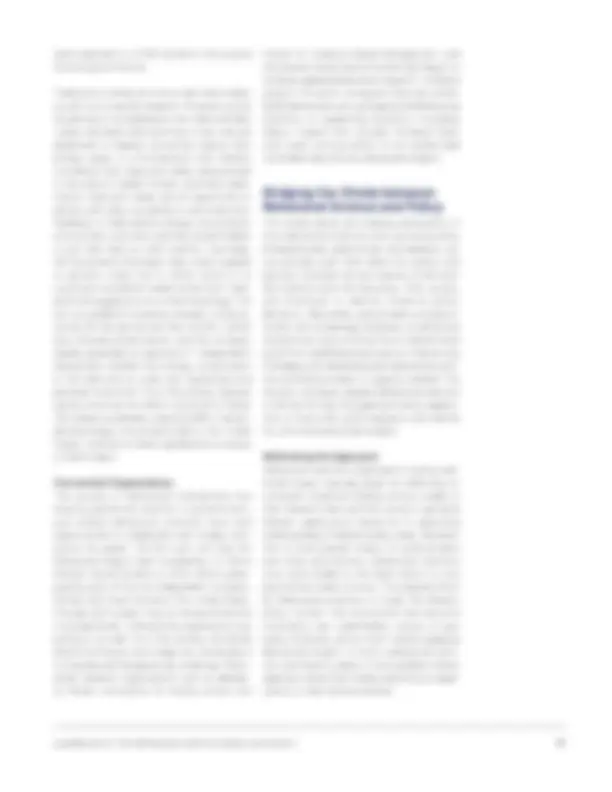
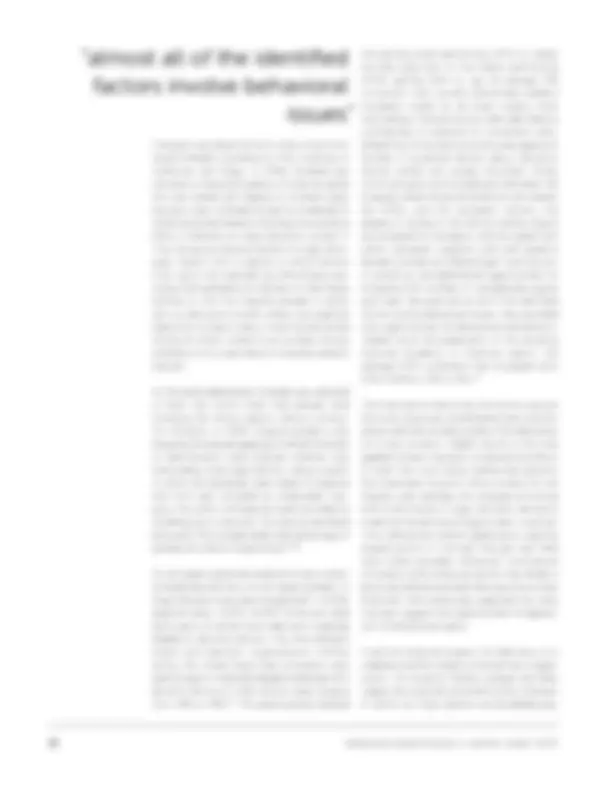
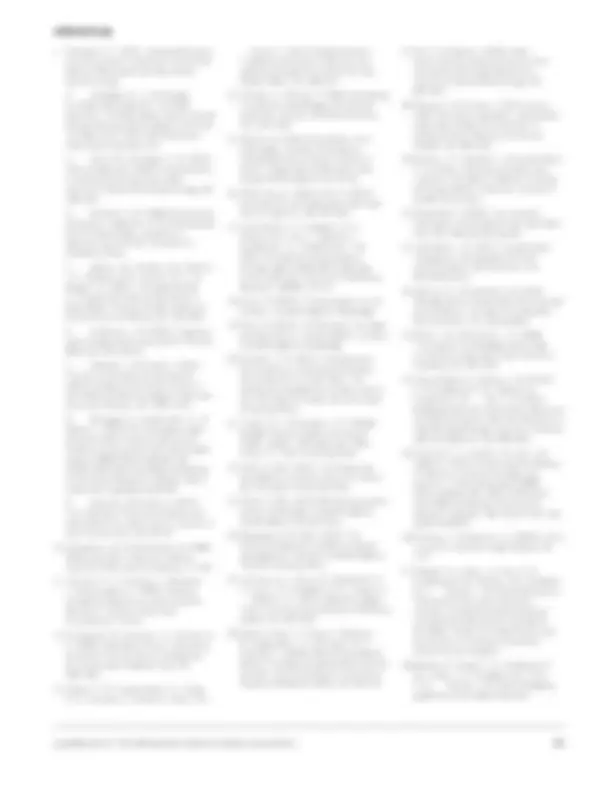
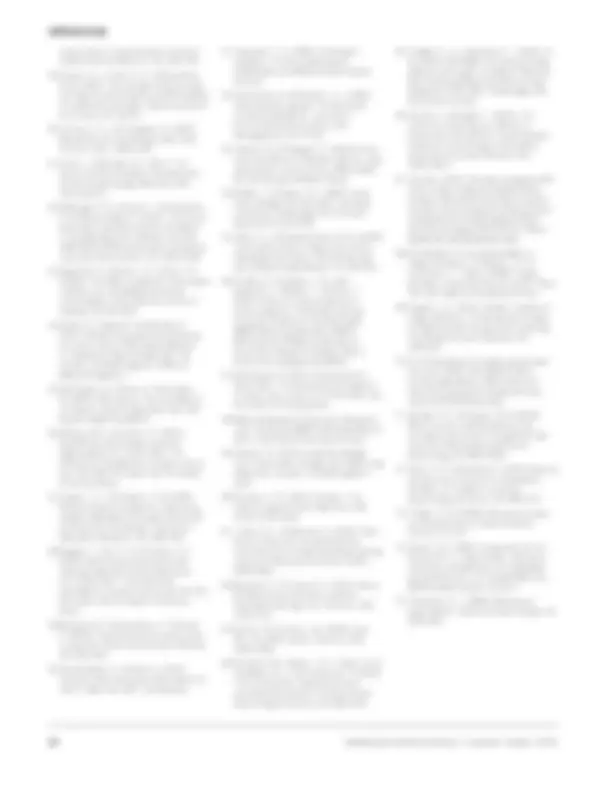


Study with the several resources on Docsity

Earn points by helping other students or get them with a premium plan


Prepare for your exams
Study with the several resources on Docsity

Earn points to download
Earn points by helping other students or get them with a premium plan
Community
Ask the community for help and clear up your study doubts
Discover the best universities in your country according to Docsity users
Free resources
Download our free guides on studying techniques, anxiety management strategies, and thesis advice from Docsity tutors
The reasons economists have been successful in influencing policy and how behavioral scientists can learn from their approaches. It also highlights case studies where behavioral scientists have made an impact and provides suggestions for more effectively bridging the gap between behavioral science and policy. The goal is to increase the supply and demand for behavioral insights in policymaking and practice.
Typology: Lecture notes
1 / 14

This page cannot be seen from the preview
Don't miss anything!









bridging the divide
between behavioral
science & policy
abstract
Fox, C. R., & Sitkin, S. B. Bridging the divide between behavioral science & policy. Behav- ioral Science & Policy, 1 (1), pp.1–14.
2 behavioral science & policy | volume 1 issue 1 2015
etter insight into human behavior by a county government official might have changed the course of world history. Late in the evening of November 7, 2000, as projections from the U.S. presidential election rolled in, it became apparent that the outcome would turn on which candidate carried Florida. The state initially was called by several news outlets for Vice President Al Gore, on the basis of exit polls. But in a stunning development, that call was flipped in favor of Texas Governor George W. Bush as the actual ballots were tallied. 1 The count proceeded through the early morning hours, resulting in a narrow margin of a few hundred votes for Bush that triggered an automatic machine recount. In the days that followed, intense attention focused on votes disallowed due to “hanging chads” on ballots that had not been properly punched. Weeks later, the U.S. Supreme Court halted a battle over the manual recount in a dramatic 5–4^ decision. Bush would be certified the victor in Florida, and thus president-elect, by a mere 537 votes.
Less attention was paid to a news item that emerged right after the election: A number of voters in Palm Beach County claimed that they might have mistakenly voted for conservative commentator Pat Buchanan when they had intended to vote for Gore. The format of the
ballot, they said, had confused them. The Palm Beach County ballot was designed by Theresa LePore, the supervisor of elections, who was a registered Democrat. On the Palm Beach County “butterfly ballot,” candidate names appeared on facing pages, like butterfly wings, and votes were punched along a line between the pages (see Figure 1). LePore favored this format because it allowed for a larger print size that would be more readable to the county’s large proportion of elderly voters. 2
Ms. LePore unwittingly neglected an important behavioral principle long known to experimental psychologists: To minimize effort and mistakes, the response required (in this case, punching a hole in the center line) must be compatible with people’s perception of the relevant stimulus (in this case, the ballot layout). 3,4^ To illustrate this principle, consider a stove in which burners are aligned in a square but the burner controls are aligned in a straight line (see Figure 2, left panel). Most people have difficulty selecting the intended controls, and they make occasional errors. In contrast, if the controls are laid out in a square that mirrors the alignment of burners (see Figure 2, right panel), people tend to make fewer errors. In this case, the stimulus (the burner one wishes to light) better matches the response (the knob requiring turning).
Core Findings
What is the issue? Neoclassical economics is indispensible to policymaking. But where it neglects the actual behavior of rational agents, behavioral science can step in. Policy outcomes can be significantly improved if behavioral science turns to a problem- driven approach and positions itself as complementary to existing policymaking tools.
How can you act? Selected recommendations include:
Who should take the lead? Behavioral and social science researchers, policymakers, and private sector leaders
4 behavioral science & policy | volume 1 issue 1 2015
Information includes education programs, detailed documentation, and information campaigns (for example, warnings about the dangers of illicit drug use). The assumption behind these interventions is that accurate infor- mation will lead people to act appropriately.
Incentives include financial rewards and punishments, tax credits, bonuses, grants, and subsidies (for example, a tax credit for installing solar panels). The assumption here is that proper incentives motivate individuals and organizations to behave in ways that are aligned with society’s interests.
Regulation entails a mandate (for example, requiring a license to operate a plane or perform surgery) or a prohibition of a particular behavior (such as forbidding speeding on highways or limiting pollution from a factory). In some sense, regulations provide a special kind of (dis)incen- tive in the form of a legal sanction.
Although tools from neoclassical economics will always be critical to policymaking, they often neglect important insights about the actual behaviors of individuals, groups, and organiza- tions. In recent decades, behavioral and social scientists have produced ample evidence that people and organizations routinely violate assumptions of the rational agent model, in systematic and predictable ways. First, individ- uals have a severely limited capacity to attend to, recall, and process information and therefore to choose optimally. 6 For instance, a careful study of older Americans choosing among prescrip- tion drug benefit plans under Medicare Part D (participants typically had more than 40 stand- alone drug plan options available to them) found that people selected plans that, on average, fell short of optimizing their welfare, by a substan- tial margin. 7,8^ Second, behavior is strongly affected by how options are framed or labeled. For example, economic stimulus payments
are more effective (that is, people spend more money) when those payments are described as a gain (for example, a “taxpayer bonus”) than when described as a return to the status quo (for example, a “tax rebate”).^9 Third, people are biased to stick with default options or the status quo, for example, when choosing health and retirement plans, 10 insurance policies, 11 flexible spending accounts, 12 and even medical advance directives. 13 People likewise tend to favor incum- bent candidates, 14 current program initiatives, 15 and policies that happen to be labeled the status quo. 16 Fourth, people are heavily biased toward immediate rather than future consumption. This contributes, for example, to the tendency to undersave for retirement. It is interesting to note, though, that when people view photographs of themselves that have been artificially aged, they identify more with their future selves and put more money away for retirement. 17
One response to such observations of irratio- nality is to apply traditional economic tools that attempt to enforce more rational decision- making. In this respect, behavioral research can serve an important role in identifying situations in which intuitive judgment and decisionmaking may fall short (for instance, scenarios in which the public tends to misperceive risks) 18,19^ for which economic decision tools like cost–benefit analysis are especially helpful. 20 More important, behavioral scientists have begun to develop powerful new tools that complement traditional approaches to policymaking. These tools are derived from observations about how people actually behave rather than how rational agents ought to behave. Such efforts have surged since the publication of Thaler and Sunstein’s book Nudge , 21 which advocates leveraging behavioral insights to design policies that promote desired behaviors while preserving freedom of choice. A number of edited volumes of behavioral policy insights from leading scholars have followed. 22–
Behavioral information tools leverage scientific insights concerning how individuals, groups, and organizations naturally process and act on information. Feedback presented in a concrete, understandable format can help people and organizations learn to improve their outcomes (as with new smart power meters in homes or
“people and organizations
routinely violate assumptions
of the rational agent model”
a publication of the behavioral science & policy association 5
performance feedback reviews in hospitals 26 or military units 27 ) and make better decisions (for instance, when loan terms are expressed using the annual percentage rate as required by the Truth in Lending Act 28 or when calorie information is presented as a percentage of one’s recommended snack budget 29 ). Similarly, simple reminders can overcome people’s natural forgetfulness and reduce the frequency of errors in surgery, firefighting, and flying aircraft. 30– Decisions are also influenced by the order in which options are encountered (for example, first candidates listed on ballots are more likely to be selected)^33 and how options are grouped (for instance, physicians are more likely to choose medications that are listed separately rather than clustered together on order lists). 34 Thus, poli- cymakers can nudge citizens toward favored options by listing them on web pages and forms first and separately rather than later and grouped with other options.
Behavioral incentives leverage behavioral insights about motivation. For instance, a corner- stone of behavioral economics is loss aversion , the notion that people are more sensitive to losses than to equivalent gains. Organizational incentive systems can therefore make use of the observation that the threat of losing a bonus is more motivating than the possibility of gaining an equivalent bonus. In a recent field experi- ment, one group of teachers received a bonus that would have to be returned (a potential loss) if their students’ test scores did not increase while another group of teachers received the same bonus (a potential gain) only after scores increased. In fact, test scores substantially increased when the bonus was presented as a potential loss but not when it was presented as a potential gain. 35
A behavioral perspective on incentives also recognizes that the impact of monetary payments and fines depends on how people subjectively interpret those interventions. For instance, a field experiment in a group of Israeli day care facilities found that introducing a small financial penalty for picking up children late actually increased the frequency of late pickups, presumably because many parents interpreted the fine as a price that they would
gladly pay. 36 Thus, payments and fines may not be sufficient to induce desired behavior without careful consideration of how they are labeled, described, and interpreted.
Behavioral insights not only have implications for how to tailor traditional economic incentives such as payments and fines but also suggest powerful nonmonetary incentives. It is known, for example, that people are motivated by their needs to belong and fit in, compare favorably, and be seen by others in a positive light. Thus, social feedback and public accountability can be especially potent motivators. For example, health care providers reduce their excessive antibiotic prescribing when they are told how their performance compares with that of “best performers” in their region 37 or when a sign declaring their commitment to responsible antibiotic prescribing hangs in their clinic’s waiting room. 38 In contrast, attempts to influ- ence health care provider behaviors (including antibiotic prescribing) using expensive, tradi- tional pay-for-performance interventions are not generally successful. 39
Nudges are a form of soft paternalism that stops short of formal regulation. They involve designing a choice environment to facilitate desired behavior without prohibiting other options or significantly altering economic incen- tives. 21 The most studied tool in this category is the use of defaults. For instance, European coun- tries with opt-out policies for organ donation (in which consent to be a donor is the default) have dramatically higher rates of consent (generally approaching 100%) than do countries with opt-in policies (whose rates of consent average around 15%).^40
Well-designed nudges make it easy for people to make better decisions. Opening channels for desired behavior (for instance, providing a potential donor to a charity with a stamped and pre-addressed return envelope) can be extremely effective, well beyond what would be predicted by an economic cost–benefit analysis of the action.^41 For instance, in one study, children from low-income families were considerably more likely to attend college if their parents had been offered help in completing a streamlined college
3.5%-13.6% increase in average 401(k) savings rate after testing a multi-pronged behavioral intervention
2% drop in average energy consumption when users were shown their neighbors’ energy use alongside their own
increase in medically eligible individuals who actually became organ donors, from 2004 to 2012, after targeting behavioral issues
a publication of the behavioral science & policy association 7
U.S. presidential administrations and Congress have relied on economists since 1921 and 1974, respectively. Think tanks populate their ranks with policy analysts who are most commonly trained in economics. Economists are routinely consulted on fiscal and monetary policies, as well as on education, health care, criminal justice, corporate innovation, and a host of other issues. Naturally, economics is particularly useful when answering questions of national interest, such as what to do in a recession, how to imple- ment cost–benefit analysis, and how to design a market-based intervention.
In contrast, behavioral scientists have only recently begun assuming positions of influ- ence on policy through new applied behavioral research organizations (such as ideas42), standing government advisory organizations (such as the British Behavioral Insights Team and the U.S. Social and Behavioral Sciences Team), and corporate behavioral science units (such as Google’s People Analytics and Microsoft Research). Behavioral scientists are sometimes invited to serve as ad hoc advisors to various government agencies (such as the Food and Drug Administration and the Consumer Financial Protection Bureau). As behavioral scientists begin to occupy more positions in such organiza- tions, this will increase their profile and enhance opportunities to demonstrate the utility of their work to policymakers and other practitioners. Many behavioral insights have been successfully implemented in the United Kingdom 59 and in the United States.^60 For example, in the United States, the mandate to disclose financial information to consumers in a form they can easily understand (Credit Card Accountability and Disclosure Act of 2009), the requirement that large employers automatically enroll employees in a health care plan (Affordable Care Act of 2010), and revisions to simplify choices available under Medicare Part D were all designed with behavioral science prin- ciples in mind.
Approaches Behavioral Scientists Have Taken to Impact Policy Although the influence of behavioral science in policy is growing, thus far there have been
few opportunities for the majority of behavioral scientists who work at universities and in nongov- ernment research organizations to directly influence policy with their original research. Success stories have been mostly limited to a small number of cases in which behavioral scientists have (a) exerted enormous personal effort and initiative to push their idea into prac- tice, (b) aggressively promoted a research idea until it caught on, (c) partnered with industry to implement their idea, or (d) embedded them- selves in an organization with connections to policymakers.
Occasionally, entrepreneurial behavioral scien- tists have managed to find ways to put their scientific insights into practice through their own effort and initiative. For instance, Univer- sity of California, Los Angeles, professor Shlomo Benartzi and University of Chicago professor Richard Thaler were concerned about Ameri- cans’ low saving rate despite the ready availability of tax-deferred 401(k) saving plans in which employers often match employee contribu- tions. In 1996, they conceived of the Save More Tomorrow (SMarT) program, with features that leverage three behavioral principles. First, partic- ipants commit in advance to escalate their 401(k) contributions in the future, which takes advan- tage of people’s natural tendency to heavily discount future consumption relative to present consumption. Second, contributions increase with the first paycheck after each pay raise, which leverages the fact that people find it easier to forgo a gain (give up part of a pay raise) than to incur a loss (reduce disposable income). Third, employee contributions automatically escalate (unless the participant opts out) until the savings rate reaches a predetermined ceiling, which applies the observation that people are strongly biased to choose and stick with default options.
“ people are strongly biased to
choose and stick with default
options”
8 behavioral science & policy | volume 1 issue 1 2015
Convincing a company to implement the program required a great deal of persistence over a couple of years. However, the effort paid off: In the first application of Save More Tomorrow, average saving rates among participants who signed up increased from 3.5% to 13.6% in less than four years. Having proven the effectiveness of the program, Benartzi and Thaler looked for a well-known company to enhance its credibility, and they eventually signed up Philips Electronics, again with a successful outcome.
Results of these field experiments were published in a 1994 issue of the Journal of Political Economy^61 and subsequently picked up by the popular press. Benartzi and Thaler were soon invited to consult with members of Congress on the Pension Protection Act of 2006, which endorsed automatic enrollment and automatic savings escalation in 401(k) plans. Adoption increased sharply from there, and, by 2011, more than half of large American companies with 401(k) plans included automatic escalation. The nation’s saving rate has increased by many billions of dollars per year because of this innovation.^62
Other researchers have sometimes managed to influence policy by actively courting attention for their research ideas. Duke University profes- sors Richard Larrick and Jack Soll, for instance, noticed that the commonly reported metric for automobile mileage misleads consumers by focusing on efficiency (miles per gallon [MPG]) rather than consumption (gallons per hundred miles [GPHM]). In a series of simple experiments, Larrick and Soll demonstrated that people gener- ally make better fuel-conserving choices when they are given GPHM information rather than MPG information. 63 The researchers published this work in the prestigious journal Science and worked with the journal and their university to cultivate media coverage.
As luck would have it, days before publication, U.S. gasoline prices hit $4 per gallon for the first time, making the topic especially news- worthy. Although Larrick and Soll found the ensuing attention gratifying, it appeared that many people did not properly understand the
MPG illusion. To clarify their point, Larrick and Soll launched a website that featured a video, a blog, and an online GPHM calculator. The New York Times Magazine listed the GPHM solution in its “Year in Ideas” issue. Before long, this work gained the attention of the director of the Office of Information and Regulatory Affairs and others, who brought the idea of using GPHM to the U.S. Environmental Protection Agency and U.S. Department of Transportation. These agencies ultimately took actions that modified window labels for new cars beginning in 2013 to include consumption metrics (GPHM, annual fuel cost, and savings over five years compared with the average new vehicle).^60
Of course, successful behavioral solutions are not only implemented through the public sector: Sometimes policy challenges are taken up by private sector businesses. For instance, Arizona State University professor Robert Cial- dini, California State University professor Wesley Schultz, and their students ran a study in which they leveraged the power of social norms to influence energy consumption behavior. They provided residents with feedback concerning their own and their neighbors’ average energy usage (what is referred to as a descriptive social norm ), along with suggestions for conserving energy, via personalized informational door hangers. Results were dramatic: “Energy hogs,” who had consumed more energy than average during the baseline period, used much less energy the following month. However, there was also a boomerang effect in which “energy misers,” who had consumed less energy than average during the baseline period, actually consumed more energy the following month. Fortunately, the researchers also included a condition in which feedback provided not only average usage information but also a reminder about desirable behavior (an injunctive social norm ). This took the form of a handwritten smiley face if the family had consumed less energy than average and a frowning face if they had consumed more energy than average. This simple, cheap intervention led to reduced energy consumption by energy hogs as before and also kept energy misers from appreciably increasing their rates of consumption.^64 Results of the study
10 behavioral science & policy | volume 1 issue 1 2015
This point was driven home to us by a story from David Schkade, a professor at the University of California, San Diego. In 2004, Schkade was named to a National Academy of Sciences panel that was tasked with helping to increase organ donation rates. Schkade thought immediately of aforementioned research showing the powerful effect of defaults on organ donation consent.^40 Thus, he saw an obvious solution to organ short- ages: Switch from a regime in which donors must opt in (for example, by affirmatively indi- cating their preference to donate on their driver license) to one that requires people to either opt out (presume consent unless one explicitly objects) or at least make a more neutral forced choice (in which citizens must actively choose whether or not to be a donor to receive a driver’s license).
As the panel deliberated, Schkade was surprised to learn that some states had already tried changing the choice regime, without success. For instance, in 2000, Virginia passed a law requiring that people applying for driver’s licenses or identification cards indicate whether they were willing to be organ donors, using a system in which all individuals were asked to respond (the form also included an undecided cate- gory; this and a nonresponse were recorded as unwillingness to donate). The attempt backfired because of the unexpectedly high percentage of people who did not respond yes.68,
As the expert panel discussed the issue further, Schkade learned that a much larger problem in organ donation was yield management. In 2004, approximately 13,000–14,000 Americans died each year in a manner that made them medically eligible to become donors. Fifty-nine different organ procurement organizations (OPOs) across the United States had conversion rates (percentage of medically eligible individuals who became donors in their service area) ranging from 34% to 78%. 68 The panel quickly realized
that getting lower performing OPOs to adopt the best practices of the higher performing OPOs—getting them to, say, an average 75% conversion rate—would substantially address transplant needs for all major organs other than kidneys. Several factors were identified as contributing to variations in conversion rates: differences in how doctors and nurses approach families of potential donors about donation (family wishes are usually honored); timely communication and coordination between the hospitals where the potential donors are treated, the OPOs, and the transplant centers; the degree of testing of the donors before organs are accepted for transplant; and the speed with which transplant surgeons and their patients decide to accept an offered organ. Such factors, it turned out, provided better opportunities for increasing the number of transplanted organs each year. Because almost all of the identified factors involve behavioral issues, they provided new opportunities for behavioral interventions. Indeed, since the publication of the resulting National Academy of Sciences report, the average OPO conversion rate increased from 57% in 2004 to 73% in 2012.^70
The main lesson here is that one cannot assume that even rigorously tested behavioral scientific results will work as well outside of the laboratory or in new contexts. Hidden factors in the new applied context may blunt or reverse the effects of even the most robust behavioral patterns that have been found in other contexts (in the Virginia case, perhaps the uniquely emotional and moral nature of organ donation decisions made the forced choice regime seem coercive). Thus, behavioral science applications urgently require proofs of concept through new field tests where possible. Moreover, institutional constraints and contextual factors may render a particular behavioral insight less practical or less important than previously supposed, but they may also suggest new opportunities for applica- tion of behavioral insights.
A second important reason for field tests is to calibrate scientific insights to the domain of appli- cation. For instance, Sheena Iyengar and Mark Lepper famously documented choice overload , in which too many options can be debilitating.
“almost all of the identified
factors involve behavioral
issues”
a publication of the behavioral science & policy association 11
In their study, they found that customers of an upscale grocery store were much more likely to taste a sample of jam when a display table had 24 varieties available for sampling than when it had six varieties, but the customers were neverthe- less much less likely to actually make a purchase from the 24-jam set. 71 Although findings such as this suggest that providing consumers with too many options can be counterproductive, increasing the number of options generally will provide consumers with a more attractive best option. The ideal number of options undoubt- edly varies from context to context, 72 and prior research does not yet make predictions precise enough to be useful to policymakers. Field tests can therefore help behavioral scientists establish more specific recommendations that will likely have greater traction with policymakers.
Although a vast reservoir of useful behavioral science waits to be repurposed for specific applications, the kind of research required to accomplish this goal is typically not valued by high-profile academic journals. Most behavioral scientists working in universities and research institutes are under pressure to publish in top disciplinary journals that tend to require signif- icant theoretical or methodological advances, often requiring authors to provide ample evidence of underlying causes of behavior. Many of these publications do not reward field research of naturally occurring behavior, 73 encourage no more than a perfunctory focus on practical implications of research, and usually serve a single behavioral discipline. There is therefore an urgent need for new high-profile outlets that publish thoughtful and rigorous applications of a wide range of behavioral sciences—and especially field tests of behavioral principles—to increase the supply of behavioral insights that are ready to be acted on.
On the demand side, although policymakers increasingly are open to rigorous and action- able behavioral insights, they do not see much research in a form that they can use. Traditional scientific journals that publish policy-relevant work tend to be written for experts, with all the technical details, jargon, and lengthy descrip- tions that experts expect but busy policymakers
and practitioners cannot decipher easily. In addi- tion, this work often comes across as naive to people creating and administering policy. Thus, new publications are needed that not only guar- antee the disciplinary and methodological rigor of research but also deliver reality checks for scientists by incorporating policy professionals into the review process. Moreover, articles should be written in a clear and compelling way that is accessible to nonexpert readers. Only then will a large number of practitioners be inter- ested in applying this work.
In this article, we have observed that although insights from behavioral science are beginning to influence policy and practice, there remains a stubborn divide in which most behavioral scientists working in universities and research institutions fail to have much impact on poli- cymakers. Taking stock of the success of economists and enterprising behavioral scien- tists, we argue for a problem-driven approach to behavioral policy research that we summarize in Figure 3.
We hasten to add that a problem-driven approach to behavioral policy research can also inspire development of new behavioral theories. It is worth noting that the original theoretical research on stimulus–response compatibility, mentioned above in connection with the butterfly ballot, actually originated from applied problems faced by human-factors engi- neers in designing military-related systems in World War II. 74 The bridge between behavioral science and policy runs in both directions.
a publication of the behavioral science & policy association 13
references
14 behavioral science & policy | volume 1 issue 1 2015
references
prescribing: A randomized clinical trial. JAMA Internal Medicine, 174, 425–431.